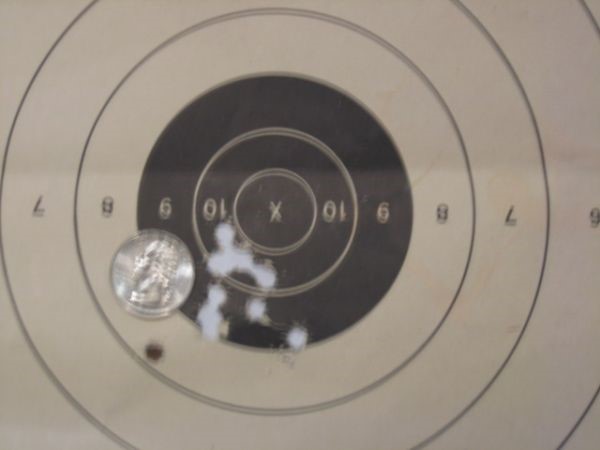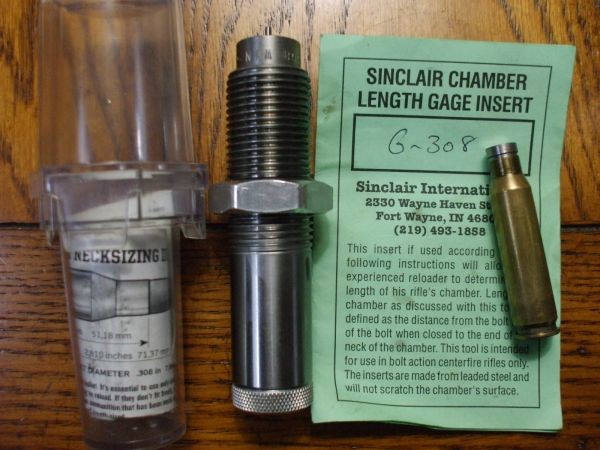I just purchase 100 new Remington 30-06 cases and a RCBS 308 form and trim die. I picked 50 cases that were close in weight with under .002 wall runout. After forming (very easy BTW) one 308 case the neck wall thickness is .0225. I need to turn the necks to .0165 to get a tighter slip fit into larger .345 neck area of factory chamber. I can also trim the cases .020 longer than recommended 3.015 for less jump from case mouth into leade. I know I will have less case volume because of thicker brass, but will this thicker brass improve accuracy?
Forming 308 from 30-06 Brass
- 4.4K Views
- Last Post 30 October 2014
It should make for more accurate loads. I did the same thing when I had a 308 years ago, but the rifle was not accurate enough to see a difference. You will also want a custom neck sizer (probably a bushing die) so you don't over-size the necks. Or if you turn the necks for about .001” clearance, you may not need to neck-size at all. The spring-back may be enough to hold the bullets. Glenn :fire
Attached Files
OU812:
Last winter I reformed 500 + - pieces of “06” brass to .308 for my 98 Mauser and a New Remington 700P. 250 military issue “06” for the Mauser and 250 new Hornady for the Remington.
I did it a little differently than you but without going into a lot of bally-ho, one thing was to measure the chamber length of each rifle and then trim the length of the reformed brass so that they ended up .015” short of the respective chamber lengths after firing the first time.
And in answer to your question, Yes, I could see a difference in my groups over the summer's military match shooting season. No long winded scientific number crunching but there were noticeably fewer unexplained flyers and more tighter groups than before.
No magic cure all answer but I am convinced that it is worth the time.
And these cases were reformed specifically for cast bullets.
Attached Files
Shoulders will be set back just far enough so that bolt closes with slight resistance and necks length will be trimmed same length as chamber neck. Cases will shorten a little after fire forming...correct? I neck size only and case will get shorter after a couple of firings...correct?
Thank you guys for the helpful advice.
Attached Files
du812::
what an opportunity for a test ... since you will be watching brass dimensions closely for a while.
regarding neck stretch.. is it true that lee collet dies don't ( hardly any ? ) stretch necks?
joe b. did a recent test on case shortening:: firing pin or primers slamming case forward .. and do they stay shortened with mild loads ? heavy loads stretching them back out ? always good to record more results .
if primers slam brass forward ... would enlarging primer pockets to 0.078 or ++ reduce forward thrust?
ken
Attached Files
OU812: My association with this K-98 Mauser .7.62x51 started when I got involved several years ago with the military matches. And only report what I have discovered since then. At the beginning I used NM military .7.62 brass. then Military issue, New Win. .308 and finally New Hornady. Over time and several reloadings, all brands shortened and continued to do so when neck sized only. Some as much as .010” under published trim length. No matter what kind of neck sizing die. A chamber length gauge told me that I already had a .040” gap when using the required trim length so this added to the shortened cases gave a gap in excess of .050” for the worst cases. Now, I am using reformed GI issue LC 30-06 brass, Trimmed to .015” short of chamber length. And only sorted visually for off center flash holes. To load, I use a Redding FL size bump bushing die. This also allows me to set whatever headspace I want when sizing. I usually try for about .002” shoulder set back which allows the bolt to close easily. And the cases don't shorten anymore after the first couple of firings. This target was one of five, shot yesterday and is posted only to illustrate the above combination. I was fiddling around with the bedding, different holds, bench technique, etc. and was one of the last groups of the day. Turned out, after all the fooling around, ended up back where I started. The one hole at the top was already there. The two, low left and right, no explanation. Ten shots, 100 yds, NOE 311332, IMR 4227. Apologize for the out of focus. Dang camera! 
Attached Files
Here is the Sinclair chamber length gage (insert diameter measures .335). My Remington VS has a chamber length of 2.046. The instructions say to trim .024 below that number, but I will try .010 since these are lower pressure cast loads. I also have the Lee collet neck sizing die I will have to try. Maybe neck length will shorten less overtime using it.
Attached Files
R. Dupraz Nice shooting! I also have that bullet (NOE 311332), but the NOE 30XCB shoots a tad better in my rifle. Looking at the chamber pound cast, you can see the gap between case mouth and leade of chamber. NOE 30XCB loaded on left.
Attached Files
-.046", That's exactly what the chamber length in my Rem. 700P measures, near as I can tell. After running the “06” cases up into a full length .308 sizing die, I rough trim to over chamber length and finish trim in a For
Attached Files
R. Dupraz
This is very good info. Thanks for sharing.
I was thinking of fire forming all the cases with “The Load” (13 grs of Red Dot). Do the thicker cases fire form well to chamber? I chose the Remington brass because some say it is softer than most all other brass and forms easier.
Attached Files
Don't know about Remington as the cases that I used were GI issue ball brass and new Hornady. The GI brass is thicker than commercial and the Hornady is hard and required annealing before reforming. Some of the GI was once fired and some were unfired. But I annealed it all anyway before forming. After a couple of firings with my load of 4227, both were expanded.
Attached Files
You need to get that camera fixed, it turned the target upside down. ;) ;)
mrbill2
Attached Files
Nope, Some poor serf stapled that target on the backboard upside down! Pretty challenging trying look through the scope while it's on the bottom though!
Attached Files
Final neck thickness after turning “turned” out to be .015. Just .001 thicker than my other .014 thick brass. I was hoping for .0165 thickness...bummer
Attached Files
My FA 60 Match brass, measures .016 thick at the neck when made into 308 Win. The neck ID is .311 when fired in a Rem 788 chamber.
Frank
Attached Files
I used a Hawkeye bore scope to check case mouth length in chamber. I ended up trimming to 3.025 for even fit inside chamber. After fire forming with 12.5 grs of Red Dot, all case shortened .005". All cases now measure 3.020” case length. 7mm-08 brass is thinner and longer. Making it easier to make longer 308 brass.
Attached Files
I am afflicted with the same nagging worry about the gap at the end of the case maybe causing trouble and wrote a Fouling Shot article about it (#214, Nov/Dec 11.) In the article I admitted that I didn't know if it made any difference and asked that if anybody knew if it made a difference to let us know. I have never heard a reply so I don't think we know yet but hard to see how it can hurt to close the gap.
I made 223 brass from 222 magnum brass. Since the difference in case length is much less than 308 and 30-06 brass I didn't get more neck thickness. But I was less conservative when trimming to length. After sizing I trimmed to only a thousandth or two less than chamber length assuming the brass would shorten when fire form which it did to give a gap of about .004". I have been using only the Lee Collet die to reload the 250 cases and case length growth has been close to non-existent. For the twenty cased that I reloaded over 200 times (TFS article on reloading in #218 July/Aug 12) I did trim them once but I don't believe any of them were contacting the end of the chamber yet. The rest of the cases have been reloaded 38 times and have never been trimmed.
Although I have used lots of very low velocity loads, some subsonic, I have never observed the cases shortening. I believe Joe found the same when he was determining that it was caused with the 308. The cases always chamber with a little resistance to the bolt closing which hasn't seemed to vary over time. It seems that the small primers don't shorten cases. John
Attached Files
Categories
- All Categories
- General Polls
- Contact Us w/ Forum Issues
- Welcome to The Cast Bullet Association Forum
- General
- Bullet Casting
-
Guns and Shooting
- AR Platform
- TC Contenders & Other Single Shot Handguns
- Shotguns
- Informal Matches & Other Shooting Events
- Gunsmithing Tips
- Gun Cleaning & Maintenance
- Optics
- Benchrest Cast Bullet Shooting
- Military Bench Rest Cast Bullet Shooting
- Silhouette Shooting
- Postal Match Cast Bullet Shooting
- Factory Guns
- Black Powder Cartridge
- Hand Guns
- Lever Guns
- Single Shot Rifles
- Bolt Action Rifles
- Military Surplus Rifles
- Plinkers Hollow
- Muzzleloaders
- Hunting
- Reloading
- Buy, Sell or Trade
- Other Information & Reference
Search
This Weeks High Earners
-
John Carlson 22
-
 linoww
17
linoww
17
-
 Bud Hyett
15
Bud Hyett
15
-
drone 9
-
MP1886 7
-
beltfed 6
-
Lucky1 6
-
 RicinYakima
5
RicinYakima
5
-
mashburn 4
-
beemer 4







